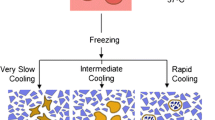Abstract
Herein we have explored two practical aspects of cryopreserving cultured mammalian cells during routine laboratory maintenance. First, we have examined the possibility of using a serum-free, hence more affordable, cryopreservative. Using five mammalian lines (Crandell Feline Kidney, MCF7, A72, WI 38 and NB324K), we found that the serum-free alternative preserves nearly as efficiently as the serum-containing preservatives. Second, we compared cryostorage of those cells in suspended versus a pellet form using both aforementioned cryopreservatives. Under our conditions, cells were in general recovered equally well in a suspended versus a pellet form.
Similar content being viewed by others
References
Polge AS, Smith AU, Parks AS. Survival of spermatozoa after dehydration and vitrification at low temperature. Nature 1949; 164:666.
Mazur P. Cryobiology: The freezing of biological systems. Science 1970; 168:939–949.
Mazur P, Leibo SP, Chu EHY. A two-factor hypothesis of freezing injury. Exp Cell Res 1971; 72:345–355.
Lovelock JE, Bishop MH. Prevention of freezing damage to living cells by dimethyl-sulphoxide. Nature 1959; 183:1394–1395.
Beckmann J, Korber CH, Rau G, Hubel A, Cravalho EG. Redefining cooling rates in terms of ice front velocity and thermal gradient: first evidence of relevance to freezing injury of lymphocytes. Cryobiology 1990; 27:279–287.
Kelbe RJ, Mancuso MG. Identification of new cryoprotective agents for cultured mammalian cells. In Vitro 1983; 19:167–170.
Lim JM, Ko JJ, Hwang WS, Chung HM, Niwa K. Development of in vitro matured oocytes after cryopreservation with different cryoprotectants. Theriogenology 1999; 51:1303–1310.
Hubel A, Cravalho EG, Nunner B, Korber C. Survival of directionaly solidified B-lymphoblasts under various crystal growth conditions. Cryobiology 1992; 29:183–198.
Acker JP, McGann LE. Cell-cell contact affects membrane integrity after intracellular freezing. Cryobiology 2000; 40:54–63.
Acker JP, Larese A, Yang H, Petrenko A, McGrann LE. Intracellular ice formation is affected by cell interactions. Cryobiology 1999; 38:363–371.
Armitage WJ, Juss BK. Assembly of intercellular junctions in epithelial cell monolayers following exposure to cryoprotectants. Cryobiology 2000; 41:58–65.
Crandell RA, Fabricant CG, Nelson-Rees WA. Development, characterization, and viral susceptibility of a feline (Felis catus) renal cell line (CRFK). In Vitro 1973; 9:176–185.
Spitzer AL, Maxwell F, Corsini J, Maxwell IH. Species specificity for transduction of cultured cells by a recombinant LuIII rodent parvovirus genome encapsidated by canine parvovirus or feline panleukopenia virus. J Gen Virol 1996; 77:1787–1792.
Spitzer AL, Parrish CR, Maxwell IH. Tropic determinant for canine parvovirus and feline panleukopenia virus functions through the capsid protein VP2. J Gen Virol 1997; 78:925–928.
Sugarman BJ, Aggarwal BB, Hass PE, Figari IS, Palladino IA Jr., Shepard HM. Recombinant human tumor necrosis factor-alpha: effects on proliferation of normal and transformed cells in vitro. Science 1985; 230: 943–945.
Binn LN, Marchwicki RH, Stephenson EH. Establishment of a canine cell line: derivation, characterization, and viral spectrum. Am J Vet Res 1980; 41:855–860.
Parrish CR, Aquadro CF, Carmichael LE. Canine host range and a specific epitope map along with variant sequences in the capsid protein gene of canine parvovirus and related feline, mink, and raccoon parvoviruses. Virology 1988; 166:293–307.
Shein HM, Enders JF. Multiplication and cytopathogenicity of simian vacuolating virus in cultures of human tissues. Proc Soc Exp Biol Med 1962; 109:495–500.
Corsini J, Maxwell F, Maxwell IH. Storage of various cell lines at −70C or −80C in multi-well plates while attached to the substratum. Biotechniques 2002; 33:1–3.
Corsini J, Maxwell IH, Maxwell F, Carlson JO. Expression of parvovirus LuIII NS1 from a Sindbis replicon for production of LuIII-luciferase transducing virus. Virus Res 1996; 46:95–104.
Hayflick L, Moorhead PS. The serial cultivation of human diploid cell strains. Exp Cell Res 1961; 25: 585–621.
Hayflick L, Plotkin SA, Norton TW, Koprowski IH. Preparation of poliovirus vaccines in a human fetal diploid cell strain. Am J Hyg 1962; 75:240–258.
Hayflick L. The limited in vitro lifetime of human diploid cell strains. Exp Cell Res 1965; 37: 614–636.
Author information
Authors and Affiliations
Corresponding author
Additional information
Published: April 7, 2004.
Rights and permissions
About this article
Cite this article
Corsini, J., Hacker, C. & Bare, C. Serum-free cryopreservation of five mammalian cell lines in either a pelleted or suspended state. Biol. Proced. Online 6, 61–66 (2004). https://doi.org/10.1251/bpo73
Received:
Revised:
Accepted:
Issue Date:
DOI: https://doi.org/10.1251/bpo73




